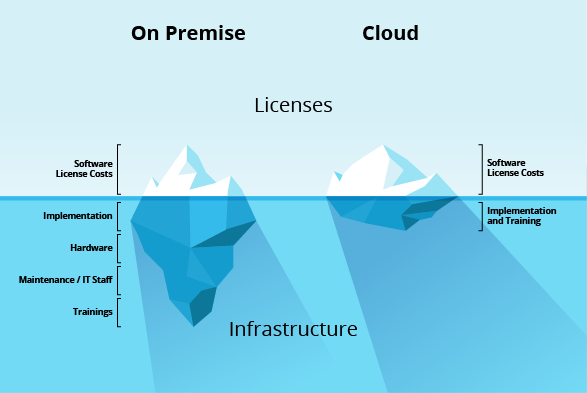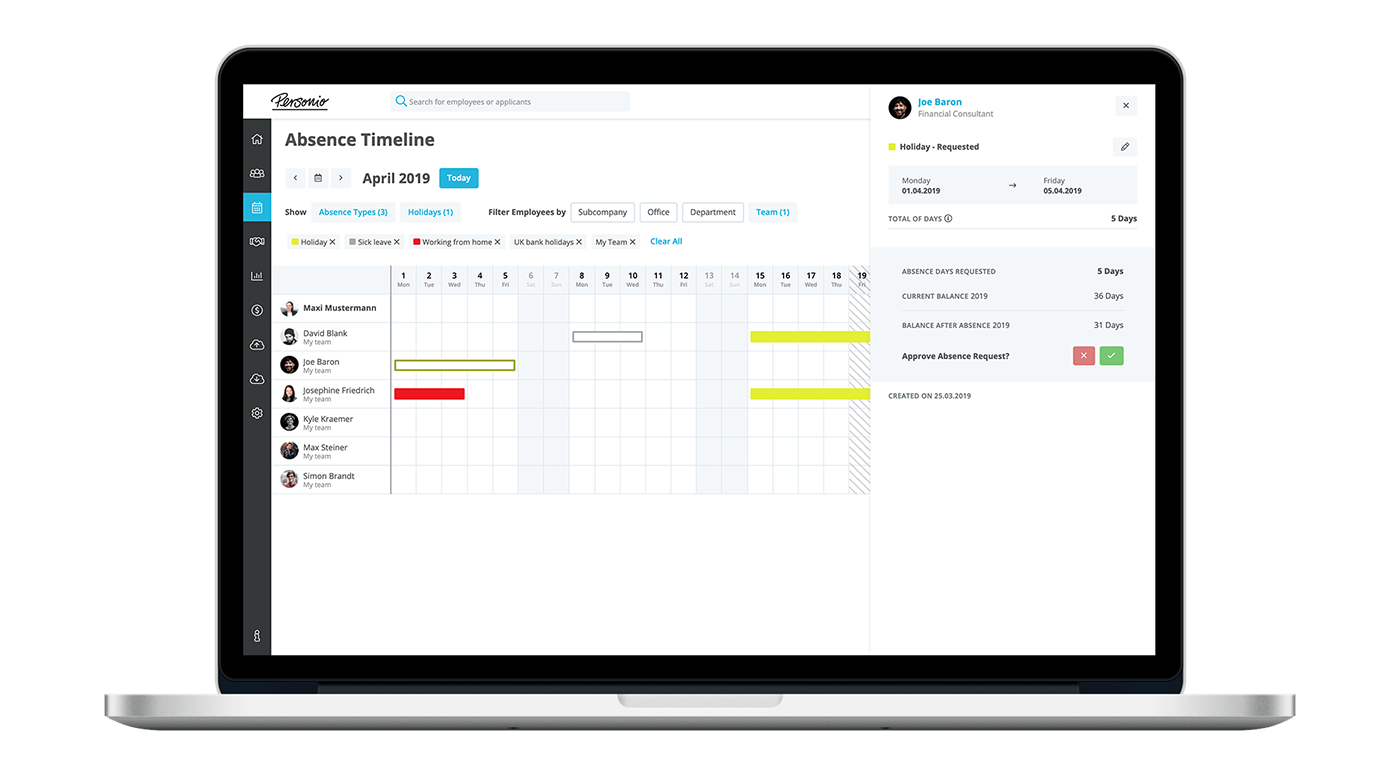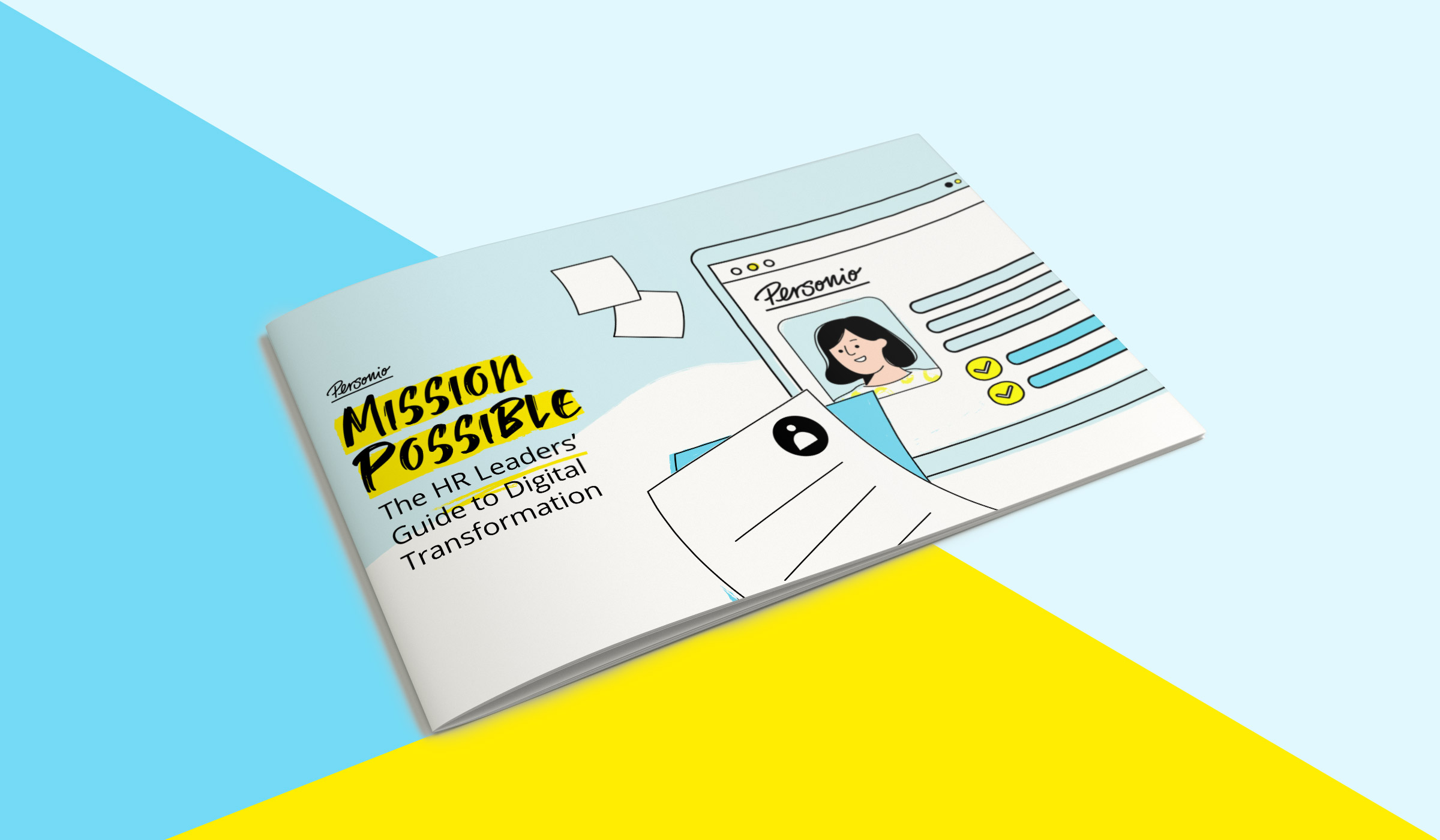While concerns persist regarding the use of HR cloud software, more and more companies use it. What are the arguments for subscribing to instead of purchasing software? How do cloud solutions compare in terms of cost and data protection? An overview of the pros and cons.
Looking for a (new) HR software? This guide helps you choosing the right one.
Contents
What is HR cloud software?
Pros and cons of HR cloud software
Can cloud-based and on-premise software be compared at all?
The cost factor
Level of data protection with HR cloud software
Success in the cloud: a market overview
Subscribing to cloud-based software or buying software outright and operating it on the premises – this is an important question you should ask yourself before buying HR software (in addition to the question of whether you want a standalone or complete solution). The decision for or against subscription-based software will most likely be guided to some extent by personal preference, but much more so by data protection considerations and costs. More about this below.
What is HR Cloud Software?
Cloud-based software is often also referred to as software as a service (SaaS) or on-demand software. These terms already suggest what distinguishes these products: You don’t buy this type of software, but subscribe to it and therefore pay a monthly fee for using it. The pricing structure will generally depend on the number of employees to be managed.
The subscription fees cover all services associated with the software. The provider takes care of all of the technical matters: operation, troubleshooting and ongoing development. All you need to do is log in to the software with your credentials, and you can then immediately start using it productively.
Your data is stored on the software provider’s servers or more likely in a data center used for hosting purposes by the software provider. As long as you have internet access, you will also have access to your data from anywhere you like.
Pros and Cons of HR Cloud Software
The fact that the “data is stored somewhere else” is the most distinctive feature of cloud-based software, but by no means the only factor that differentiates it. Read on for an overview of its pros and cons:
Functionality
Cloud-based solutions offer a defined scope of functions, which can be adapted to individual requirements. Selected functions can be activated or deactivated. With HR cloud solutions, the many different functions are well-coordinated so that they can be easily operated by a wide range of users. Given the large number of providers, you’re bound to find a solution that offers the functions you need.
Innovation
SaaS providers develop their solutions on an ongoing basis, as their customers demand something in return for their monthly subscription fees. As soon as the provider releases and rolls out new functions or fixes (i.e. activates these within the software), they are immediately available to all customers at no extra cost and with no additional work. You do not need to request additional budget or plan an IT project to be able to use new features and the latest product version.
Reliability
Ensuring seamless operation and constant availability are among the core tasks of any cloud software provider. Data is hosted in state-of-the-art data centers with multiple (“redundant”) sets of hardware. If one set breaks down, there is always an alternative. Providers guarantee availabilities of 99.9% and higher. Calculated over the year, this means that the software may fail for only a few hours in total and must otherwise be reliably accessible.
Scalability
Scalability means that software is able to “grow” with your company, i.e. that it is suitable for more intensive usage and larger numbers of users, should the need arise in the future. It also means that scaled-up software will continue to run fast and seamlessly. This is particularly important for you if you are the HR manager at a rapidly growing company.
With cloud-based software, you don’t have to worry about future growth, as you’ll easily be able to subscribe to larger user numbers and extended functions. If you need more or faster servers to access these services, the provider will take care of that in the background.
One benefit of cloud-based solutions is their speed.
Get a 30 minute personalized web demo through Personio, our product experts will answer any questions you may have
Accessibility
You can access your cloud-based HR software from anywhere, as long as you are online and run a browser. Even the device is irrelevant, as the software can be accessed from desktop or laptop computers, tablets and smartphones. The only thing that can jeopardize your access and use is a network outage or gaps in network coverage. Continuous internet access is therefore essential.
However, while this ease of online access is certainly user-friendly, it also harbors certain security risks. Theoretically, anybody can use the internet to access your software login page and attempt to penetrate your system. To prevent that, providers employ a range of state-of-the-art security measures. Secure passwords are an absolute must.
Interfaces & Integration
Cloud-based solutions come with a number of standard interfaces and can be integrated into your existing system framework. Developing customized interfaces for your systems, in contrast, is usually not possible or extremely costly.
Accounts & Taxes
For your accounting department, it makes a significant difference whether you purchase or subscribe to HR software. The cost of software licenses and internal developments has to be capitalized (i.e. shown as fixed assets) and written down over several years. The subscription costs of SaaS solutions, in contrast, are tax-deductible operating expenses incurred monthly.
Is it Possible to Even Compare Cloud-Based and On-Premise Software?
Software you operate yourself (so-called on-premise software) is only ever as good as your IT department. As a result, comparisons are difficult. If you have generous budgets, sophisticated server technology and offices full of developers, your internally developed software will most likely be better than any cloud-based solution.
However, if your IT resources are limited, as is often the case, you’ll need to examine very carefully whether you’ll be able to operate purchased software at all, or how well you’ll be able to do that. Any direct comparison between SaaS and on-premise HR software should therefore only be drawn against the background of your own resources.
Download our guide “8 Steps to the Right HR Solution”
The Cost Issue

This comparison shows: Cloud appears more expensive at first glance, but in terms of infrastructure, it is way easier to handle.
Because an objective comparison is difficult, decisions are frequently based on costs. This often results in cloud-based software getting rejected. The reason for this is cost transparency. If HR software costs €2,500 per month for a company with 500 employees (a realistic assumption), it’s easy to calculate that the annual cost will be €30,000.
If you then compare this with one-off license fees of €20,000 for purchasing HR software, the decision seems to be a no-brainer. But this type of comparison is not only unfair, it is also dangerous, as it often does not consider the costs of maintaining, operating and further developing purchased software. In this regard, it is often claimed that companies would need to pay their IT staff anyway and internal servers have already been purchased and are not being fully utilized.
However, this assumption usually very quickly turns out to be wrong. Software bugs are often left unaddressed, or specialist departments are made to wait several months for needed features because the IT department is overworked already or the person in charge is simply off sick. That – if not sooner – is when it becomes clear that internal IT resources don’t come free. And this does not even take into account the impact of poorly maintained HR software on your HR managers’ productivity, or the length of time it takes you to fill positions. Furthermore, you need to pay extra for each update to a new version, if you can get the necessary funds approved in the first place.
As a result, you should consider all of the costs incurred when seriously comparing the costs of cloud-based and on-premise solutions. In IT speak, this approach is referred to as “total cost of ownership” (TCO). As a rule, you can assume that cloud-based solutions are more economical for small businesses. The larger a company, the more financially attractive it becomes to operate software on-premise.
Data Protection Levels with HR Cloud Software
HR software on third-party servers? That does sound problematic initially, as employee data are among the most sensitive data imaginable. If you are concerned about data security and protection with cloud-based HR software, ask yourself the following question: “Are we as a company truly able to deliver a higher level of security than a specialized SaaS provider?”
Software providers are very much aware of their responsibility in terms of data protection. They employ entire departments that are fully aware of all of the current legal requirements and work constantly to ensure that both software and hardware are secure. Your data is stored in high-end data centers that have much in common with high-security prisons. (Example) Nothing and nobody gets in or out without being noticed, neither through the doors nor through the cables.
When selecting cloud-based software, be careful that data is only stored and processed within Europe. Read the security and data protection information closely and request copies of relevant certifications. Good providers will be prepared, have the necessary contracts in hand and offer you additional support in the form of guidelines and checklists, for example to help you meet compliance requirements.
Apart from large corporations, there would be hardly any company able to go to the same lengths efficiently. Just because data is stored on “your own” servers doesn’t necessarily mean that it is secure. If you decide to procure software from a reputable provider and use it responsibly, there’s no need for you to seriously worry about data protection.
Success in the Cloud: A Market Overview

Source: IDC
The simple fact that more and more companies use cloud-based HR software already suggests that most concerns about this type of software are unfounded and that its use is in fact economical. Not having to worry about the technology, getting access to ever more innovative functions and being able to access the software from anywhere are all impressive arguments.
Evidently, large companies are better able to operate and develop their own software. But even they have come to use SaaS solutions in many areas of HR. After all, HR software isn’t meant to make more work for IT departments – its purpose is to support HR managers in doing their work better, faster and with more enjoyment.
Download Our
Guide Today






